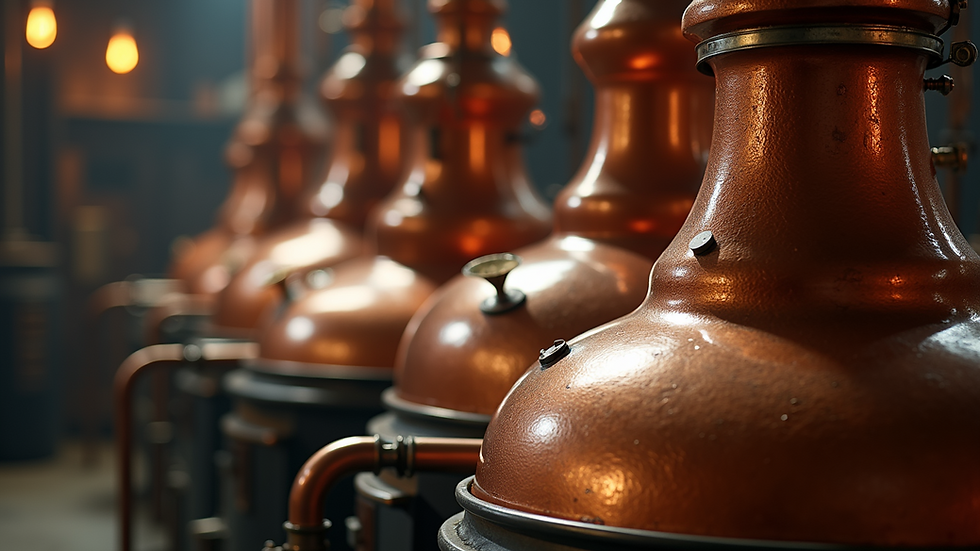Inside the Gin Production Process
- Inès Fortemps de Loneux
- Oct 8
- 4 min read
Gin is a beloved spirit known for its distinctive flavour, which comes from a blend of botanicals, with juniper berries at the heart. But how exactly does this complex and aromatic drink come to life? Understanding the gin making process reveals the craftsmanship and precision behind every bottle. From selecting ingredients to distillation and bottling, each step plays a crucial role in defining the character of the gin.
The Gin Making Process: From Raw Ingredients to Distillation
The journey begins with the selection of raw materials. The base spirit for gin is usually a neutral grain spirit, often made from wheat, barley, or corn. This spirit is distilled to a high purity to ensure it is flavourless and smooth, providing a clean canvas for the botanicals.
Next comes the choice of botanicals. Juniper berries are mandatory, giving gin its signature piney and resinous notes. Alongside juniper, distillers add a variety of other botanicals such as coriander seeds, angelica root, citrus peels, cardamom, and orris root. Each distillery has its own secret recipe, which can include up to a dozen or more botanicals.
Once the botanicals are selected, they are either macerated in the base spirit or placed in a basket within the still. Maceration involves soaking the botanicals in the spirit for a period, allowing the flavours to infuse. Alternatively, vapour infusion passes alcohol vapour through the botanicals, extracting delicate aromas without overpowering the spirit.
The distillation itself is a critical phase. It is usually done in copper pot stills, which help remove impurities and enhance flavour. The distiller carefully controls the temperature and timing to capture the "heart" of the distillate, the portion with the best flavour profile. This process may be repeated multiple times to achieve the desired purity and complexity.

Understanding the Role of Botanicals in the Gin Making Process
Botanicals are the soul of gin. Each botanical contributes unique flavours and aromas, creating a complex and balanced spirit. Juniper berries provide the classic piney, resinous notes, but the other botanicals add layers of citrus, spice, floral, and earthy tones.
For example, coriander seeds add a spicy, citrusy flavour, while angelica root brings an earthy, woody character. Citrus peels, such as lemon or orange, add brightness and freshness. Cardamom introduces a sweet, aromatic spice, and orris root helps bind the flavours together with its floral and woody notes.
The quantity and combination of botanicals are carefully calibrated. Distillers often experiment with different ratios and botanicals to create a signature flavour profile. Some gins are more juniper-forward, while others highlight citrus or floral notes.
The method of botanical infusion also affects the final taste. Maceration tends to produce a richer, more robust flavour, while vapour infusion results in lighter, more delicate aromas.

Is Gin Just Vodka with Juniper?
A common question is whether gin is simply vodka with juniper added. While both spirits start with a neutral base, the answer is more nuanced.
Vodka is typically distilled to be as neutral and flavourless as possible. It is often filtered multiple times to remove impurities and any residual taste. Gin, on the other hand, is intentionally flavoured with botanicals, with juniper being the defining ingredient.
The key difference lies in the distillation and flavouring process. Gin undergoes a second distillation with botanicals, which imparts complex aromas and tastes. Vodka usually does not have this botanical infusion step.
Therefore, gin is not just vodka with juniper; it is a distinct spirit with a unique production method designed to highlight botanical flavours. The artistry in gin making lies in balancing these botanicals to create a harmonious and enjoyable drink.

The Final Steps: Dilution, Bottling, and Quality Control
After distillation, the gin is typically too strong to drink, often reaching 70% ABV or higher. It is diluted with pure water to the desired bottling strength, usually between 37.5% and 47% ABV, depending on legal requirements and brand style.
Before bottling, the gin undergoes quality control tests to ensure consistency in flavour, aroma, and alcohol content. Some distilleries also allow the gin to rest for a short period to let the flavours marry.
Bottling is the final step, where the gin is filled into bottles, labelled, and packaged for sale. Some gins are filtered to remove any cloudiness, especially if they contain natural botanicals or are designed to be crystal clear.
The packaging often reflects the brand’s identity, with distinctive bottle shapes and labels that tell the story of the gin’s origin and production.
Exploring the Art and Science Behind Gin
The gin production process is a fascinating blend of art and science. It requires a deep understanding of ingredients, chemistry, and sensory perception. Distillers must balance tradition with innovation, respecting classic methods while experimenting with new botanicals and techniques.
For enthusiasts and aspiring distillers, learning about the gin making process offers insight into why gins taste so different from one another. It also highlights the craftsmanship involved in creating a spirit that is both versatile and complex.
Whether enjoyed neat, in a classic gin and tonic, or in creative cocktails, gin’s unique character is a testament to the skill and passion behind its production.
Exploring the gin making process reveals the dedication and expertise required to craft this iconic spirit. From selecting botanicals to distillation and bottling, every step shapes the final product. Next time you enjoy a glass of gin, you can appreciate the journey it took from raw ingredients to your cup.



Comments